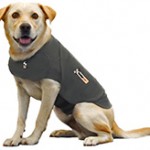 Thundershirt Yellow Labrador Dog
Just like people, pets are prone to anxiety. Unfortunately, unlike people, pets are not equipped to rationalize the reasons for which certain stimuli are causing their behaviors. They cannot talk themselves down off of a ledge, practice their deep breathing exercises, or focus on a calming place and time in their lives. An anxious pet may attempt to scape, destroy its environment, pace, pant, salivate, self-mutilate, vocalize, or show a variety of other signs.
Thunderstorms, fireworks, confinement away from a preferred person or animal companion, and other triggers can elicit anxiety in a pet. In preparation for the onslaught of potential pyrotechnic pet trauma, I teamed with pet360 and Thundershirt for a Twitter chat about pet anxiety. Here's the wrap up our #PetAnxiety conversation courtesy of PupPourri (thank you for compiling the juicy bits).
Thundershirt Yellow Labrador Dog
Just like people, pets are prone to anxiety. Unfortunately, unlike people, pets are not equipped to rationalize the reasons for which certain stimuli are causing their behaviors. They cannot talk themselves down off of a ledge, practice their deep breathing exercises, or focus on a calming place and time in their lives. An anxious pet may attempt to scape, destroy its environment, pace, pant, salivate, self-mutilate, vocalize, or show a variety of other signs.
Thunderstorms, fireworks, confinement away from a preferred person or animal companion, and other triggers can elicit anxiety in a pet. In preparation for the onslaught of potential pyrotechnic pet trauma, I teamed with pet360 and Thundershirt for a Twitter chat about pet anxiety. Here's the wrap up our #PetAnxiety conversation courtesy of PupPourri (thank you for compiling the juicy bits).
******************************
Last night, I had the privilege of sitting in on a very informative Twitter Chat about Pet Anxiety. With summer storms with lots of thunder popping up daily and the 4th of July on the horizon, what a great topic to be covered It was hosted by @Pet360 of Pet 360, Guest speakers were @PatrickMahaney a holistic veterinarian specializing in acupuncture/pain management & @Thundershirt for dogs and cats to help relieve their anxiety and calm them down during stressful situations. Here are some of the questions and answers of the night: Why does thunder scare dogs? *Loud noises, including thunder, stimulates a dogs basic instinct to flee for safety. Why do dogs start pacing long before the thunder starts? *Animals are keenly sensitive to environmental & barometric changes. Are there certain breeds/pets that are more prone to anxiety *Yes in both dogs and cats: -Terriers, Retrievers, Sporting, (Weimaraner, Viszla, etc) & working dogs (Border Collie, etc) are the most prone in dogs. - Cats that are relatively "wild" like Bengal, Occicat & Savannah don't do well with stress of domestic confinement. How can I relieve this stress or anxiety? * Exercise, distracting sounds, massage or medication. -Medication should be used as part of the treatment for anxiety and should never be the sole therapeutic option What are some non-medication alternatives? * Behavioral stimulation, including: exercise, environmental enrichment, acupuncture, acupressure, Chinese medicine food, therapeutic herbs, massages. etc. What is considered environmental enrichment? *Interactive training, distracting toys... How do pets develop these loud noise anxieties? Is it inherent fear or developed early in life? *It is instinctual but can develop with repeated exposure. If one dog is afraid of thunder and the other one is not, should you separate them during a storm? *It depends on how severe the anxiety is. Especially if removing the companion dog makes it worse I wouldn't. Don't those wraps help dogs with Thunder? *Thundershirts can help pets with any type of anxiety. Is is safe to leave Thundershirts on for long periods of time? *Yes, many clients leave them on all day while they are at work. This is not all of the questions from the night but a basic recap. If you would like to learn more about Thundershirts you can click on this link: Learn more about Thundershirts******************************
I'm a moderate the Community Question/Answer board for pet360. Feel free to drop in and submit your pet health or behavior question. To receive my next article via email, sign up here. Please feel free to communicate with me through Twitter (@PatrickMahaney) and follow my adventures in veterinary medicine by liking Patrick Mahaney: Veterinarian Acupuncture Pain Management for Your Pets on Facebook. Copyright of this article (2012) is owned by Dr Patrick Mahaney, Veterinarian and Certified Veterinary Acupuncturist. Republishing any portion of this article must first be authorized by Dr Patrick Mahaney. Requests for republishing must be approved by Dr Patrick Mahaney and received in written format.